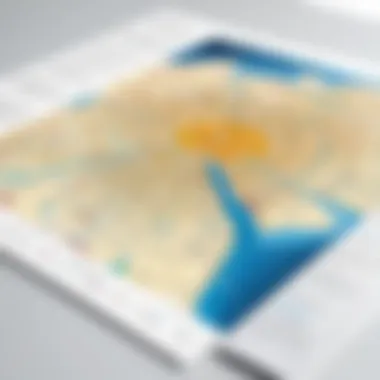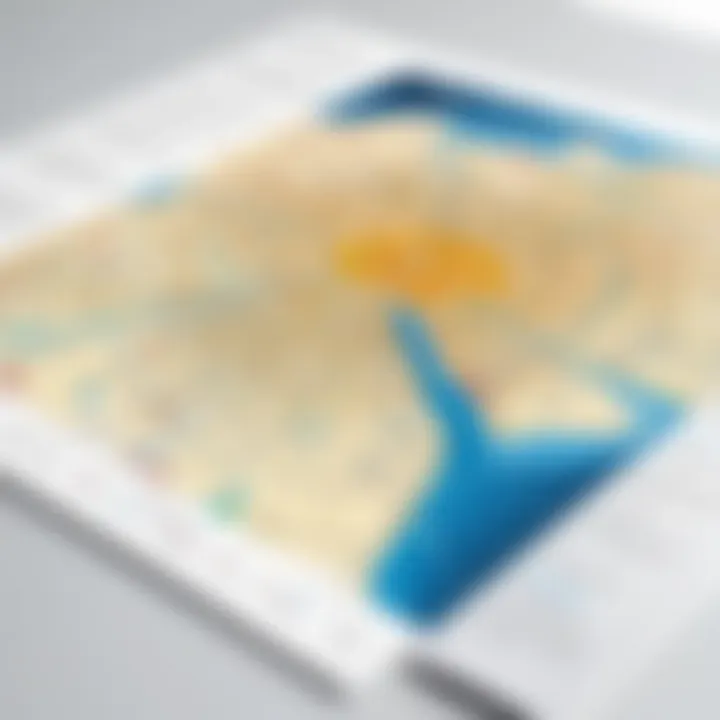Exploring Maptitude Mapping Software: Functions & Benefits


Intro
In today’s data-driven world, visualizing geographic information effectively can be a game-changer for businesses and organizations. With the right mapping software, decision-makers can uncover patterns, identify trends, and make informed choices swiftly. Maptitude mapping software stands at the forefront of this necessity, providing a powerful set of tools that cater to various sectors, ranging from logistics to urban planning. This article will guide you through the multifaceted nature of Maptitude, exploring its core functionalities and practical applications in real-world scenarios.
Software Category Overview
Definition and Importance
Mapping software is more than just a tool; it’s a vital component for organizations that rely on geographic data for strategic planning and operational efficiency. Maptitude offers intricate features that allow users to translate complex data sets into visual formats. This capability ensures that insights are not lost in translation, granting businesses the ability to engage in comprehensive analyses and data storytelling.
Key Characteristics
- User-Friendly Interface: Navigating Maptitude's features is simple, allowing even those with minimal technical expertise to leverage its capabilities.
- Data Visualization: Maptitude transforms raw geographic data into engaging visual maps, facilitating better comprehension of spatial relationships.
- Customizability: Users can tailor maps to their specific needs, making it easy to highlight key information relevant to their unique objectives.
- Geographic Analysis Tools: The software includes built-in analytics tools, empowering users to perform intricate analyses and draw conclusions that aid in decision-making.
"Mapping isn’t just about where things are; it’s about understanding relationships and patterns that inform choices."
Comparative Analysis of Top Software Options
Feature Comparison
In the competitive landscape of mapping software, Maptitude distinguishes itself through several notable features:
- Advanced Geocoding: The ability to convert addresses into geographic coordinates, streamlining location-based analyses.
- Integration Capabilities: Maptitude allows integration with various data sources like Microsoft Excel, facilitating data import and export.
- Map Creation Tools: A rich assortment of map creation tools, including thematic mapping, helps illustrate specific data points vividly.
- Timestamped Analysis: Users can analyze changes in data over time, providing insights into trends that might affect future decisions.
Pricing Models
When selecting mapping software, pricing is a crucial consideration. Maptitude typically follows a competitive pricing strategy that makes it accessible to both startups and established enterprises. Users often find that Maptitude’s investment pays off swiftly due to its numerous capabilities and effectiveness.
In summary, understanding the landscape of Maptitude mapping software—including its core features and competitive positioning—equips decision-makers and professionals with an authoritative grasp of how to leverage this powerful tool in their own organizations. Embracing such technology can catalyze a transition towards data-backed decision-making, propelling businesses toward greater efficiency and insight.
Preface to Maptitude Mapping Software
In today's data-driven age, effective mapping solutions have become vital tools for a myriad of industries. The ability to visualize and analyze geographical data translates into better decision-making, strategic planning, and overall operational efficiency. Maptitude mapping software stands out in this realm, offering powerful tools tailored to the unique needs of professionals. This section delves into why Maptitude is not merely another mapping software but a cornerstone for many organizations.
Overview of Mapping Software
Mapping software generally plays a critical role in processing complex geographical information. Imagine a city's transportation systems or environmental data visuals; these help convey what might be lost in mere numbers. Mapping tools, like Maptitude, provide interactive features, allowing users to interpret vast datasets in a visually digestible format.
A few key features that mapping software like Maptitude often offers include:
- Data Layering: Enables users to combine various datasets for comprehensive insights.
- Interactivity: Users can engage with maps in real-time, adjusting parameters and viewing immediate results.
- Reporting Tools: Generate robust reports based on analyzed geographical trends.
As the needs of businesses expand, robust mapping solutions are no longer a luxury—they're a necessity.
Historical Context of Maptitude
The roots of Maptitude can be traced back to a growing demand for sophisticated geographical data solutions in the early 1990s. Founded by Caliper Corporation, Maptitude initially catered to the needs of urban planners and businesses looking for insightful geographical information. As technology evolved, so did Maptitude. With each decade, users experienced enhancements that aligned with emerging geographic information systems technology.
The software has undergone numerous iterations, expanding its capabilities incredibly. From basic mapping functions to complex geospatial analysis, Maptitude flows with the changing tides of technology. This adaptability speaks volumes about its commitment to meeting user expectations.
Through its enduring journey, Maptitude has faced stiff competition but has consistently innovated, ensuring it remains relevant. In a world awash with geographical data, Maptitude’s historical evolution has positioned it as a distinct leader in mapping software.
Core Features of Maptitude
In the competitive landscape of mapping software, understanding the core features of Maptitude is crucial for decision-makers, IT professionals, and entrepreneurs alike. This analysis will cover three main aspects: Data Visualization, Geographic Information Systems (GIS) Integration, and Customizable Mapping Solutions. Each category highlights not only its significance but also the impact these features have on enhancing overall functionality and user experience.
Data Visualization
Data visualization stands at the heart of Maptitude’s effectiveness. In a world drowning in data, the ability to translate complex information into visual formats can make all the difference. Maptitude allows users to create various types of maps—from heat maps to choropleth maps—each tailored to display specific datasets clearly and effectively. This level of visualization aids in drawing insightful comparisons and trends that might otherwise be hidden in raw data statistics.
For instance, a retail chain can utilize Maptitude to visualize sales figures across different regions, which enables easy detection of high-performing areas and identification of lagging sales territories. Visualizations can also include demographic overlays, enriching data context and providing a well-rounded perspective for strategic decisions. Not only does this facilitate better decision-making, but it also transforms the presentation of information, fostering greater stakeholder engagement.
Geographic Information Systems Integration
Maptitude shines in its capability to integrate with Geographic Information Systems (GIS). This powerful integration means users can harness the full spectrum of spatial data for more sophisticated analysis and insight generation. By incorporating GIS into their workflows, organizations can perform in-depth geographic analyses that extend far beyond simple mapping.
For example, urban planners can incorporate zoning laws, land use data, and environmental factors into their projects, creating multi-layered maps that tell a comprehensive story about potential developments. This integration supports critical assessments, such as risk modeling for natural disasters or urban sprawl impact, highlighting its role in informed decision-making.
The ease of integration with other GIS tools ensures that Maptitude's users maintain a competitive edge. It allows for smooth transitions when migrating or synchronizing data across platforms, fostering a seamless workflow that prioritizes efficiency.
Customizable Mapping Solutions
Another hallmark of Maptitude is its customizable mapping solutions, which empower users to tailor their maps to meet specific needs. The flexibility in design and feature configuration is what sets Maptitude apart from its competitors. From color schemes to map layers, users can create visual representations that cater to diverse audience tastes and preferences.
Such customization is particularly beneficial when addressing diverse audiences or stakeholders. By allowing users to mold their maps according to their needs, Maptitude promotes inclusivity in decision-making processes.


Furthermore, specific industries benefit from unique customization features. For instance, the healthcare sector can adjust mapping templates to represent data on patient distribution and healthcare facility locations accurately, thus enhancing service delivery.
"With Maptitude, the power of customization allows organizations to communicate their narratives effectively, ensuring that both insights and visual appeal are achieved."
Advantages of Using Maptitude
Using Maptitude mapping software presents a range of advantages that can significantly enhance the way organizations operate and make decisions. It's vital to understand how these specific elements can influence everything from strategic planning to day-to-day management. Each benefit is interconnected, contributing to a powerful toolkit that helps users harness geographical data effectively.
Enhanced Decision-Making
One of Maptitude’s standout features is its ability to enhance decision-making. By providing powerful visualization tools, users can see data in a geographical context, which can lead to more informed choices. For instance, a city planner can visualize population density maps alongside transportation networks, enabling them to identify areas that require more public transport services. This spatial awareness allows decision-makers to spot trends, assess potential impacts, and allocate resources effectively.
Moreover, the software supports various data formats and integration with Geographic Information Systems (GIS), further enriching the user’s decision-making capacity. With a clear visual representation of complex datasets, organizations can navigate through what often feels like a sea of information, avoiding missteps that could arise from misinterpretation.
Informed decisions often lead to better outcomes, and Maptitude is designed to offer clarity through its vivid visualizations.
Improved Operational Efficiency
Another significant advantage of Maptitude is its contribution to operational efficiency. Traditional methods of analyzing and presenting geographical data can be labor-intensive and prone to error. Maptitude streamlines this process, allowing users to automate various mapping tasks.
For example, consider a logistics company striving to optimize delivery routes. Maptitude can analyze traffic patterns, road conditions, and delivery locations, providing optimal route suggestions. This means deliveries are made faster and potentially saves on fuel costs. Additionally, the software allows teams to collaborate more effectively by sharing maps and data insights in real-time, reducing operational silos that can slow down progress.
Key Points for Improved Efficiency:
- Automation of repetitive tasks: Users can set parameters that automate map generation and data analysis.
- Real-time collaboration: Teams can work together seamlessly, whether they are in the same office or spread across different locations.
- Integrative capabilities: Maptitude works with various data sources and platforms, ensuring compatibility with existing systems.
Cost-Effectiveness Compared to Competitors
When it comes to cost-effectiveness, Maptitude often stands out against its competitors. While certain mapping solutions can come with hefty price tags or licensing fees, Maptitude offers a range of pricing tiers that cater to businesses of different sizes. Companies can gain access to a rich feature set without breaking the bank.
Additionally, the speed at which users can derive insights through Maptitude can translate into financial savings. By reducing the time spent on data analysis and mapping, organizations can allocate their time and resources toward essential business functions. The overall return on investment increases, as the initial purchase cost is recovered through increased efficiency and better decision-making.
Industry Applications of Maptitude
Maptitude mapping software has carved out a significant niche within various industry sectors. It’s more than just a tool; it’s a strategic asset that enhances the decision-making capabilities for businesses of all sizes. Understanding the diverse applications of this software is paramount for stakeholders who aim to leverage its strengths for tangible outcomes in their respective fields.
Urban Planning and Development
In urban planning, Maptitude serves as a guiding compass. Planners can visualize demographic data, land use, and infrastructural elements seamlessly. For instance, when a city council is considering a new public transit route, Maptitude’s detailed mapping and data visualization capabilities allow for a comprehensive analysis of potential impacts. This not only enhances the planning process but also facilitates better community engagement, allowing citizens to understand and contribute to decisions affecting their lives.
- Data Integration: Urban planners can integrate various data types, from socio-economic to environmental, ensuring a holistic approach.
- Stakeholder Collaboration: The software's shareable maps can be crucial in discussions with community stakeholders, providing clear visualizations that speak volumes.
Transportation and Logistics
Transportation and logistics stand to gain immensely from Maptitude’s functionalities. Companies can optimize delivery routes, monitor fleet movements, and analyze traffic patterns. A real-world example can be seen with a logistics company using Maptitude to re-evaluate its distribution center locations based on market demands and transportation costs.
- Route Optimization: It offers algorithms that calculate the most efficient delivery routes, saving both time and fuel costs.
- Real-Time Analysis: Tracking shipments and adjusting routes in real time is now possible, adding agility to operations in today’s fast-paced market.
Retail and Market Analysis
Retailers are leveraging Maptitude to fine-tune their market strategies. By analyzing demographic data and market potential, businesses can pinpoint ideal locations for new storefronts or tailor their marketing efforts to specific neighborhoods. For instance, a fashion retailer might utilize Maptitude to identify untapped markets by overlaying consumer demographics with existing location data.
- Sales Performance Mapping: Understanding which areas bring in the most revenue can refine inventory and staffing strategies.
- Customer Segmentation: By visualizing customer behavior, retailers can create targeted marketing campaigns leading to increased customer engagement.
Environmental Studies
Finally, environmental studies utilize Maptitude to visualize ecological data against geographical backdrops. Researchers can illustrate the impact of urban sprawl on biodiversity, for instance, or track changes in land use over time. Using Maptitude, a conservation group might want to tackle deforestation. They can virtually overlay various datasets to visualize the most affected areas and prioritize their interventions effectively.
- Impact Assessment: It's critical in evaluating how new projects might affect the environment, thus providing data-driven insights to policymakers.
- Resource Management: Understanding natural resources distribution helps in sustainable planning, ensuring that future generations have resources available to them.
“Maptitude is not just a mapping tool; it’s a partner in crafting data-driven decisions across multiple disciplines.”
User Experience and Interface
The user experience (UX) and interface design of Maptitude mapping software play a pivotal role in how effectively users can leverage its capabilities. A well-designed interface not only enhances usability but also helps users navigate through its robust set of features with ease. This importance transcends mere aesthetics; it directly influences productivity and overall satisfaction with the software.
Design Elements and Usability
Maptitude’s interface is anchored by a thoughtful arrangement of design elements aimed at fostering intuitive usability. Key features include customizable toolbars and a logical layout that allows users to add and remove tools as per their needs. This flexibility means that both seasoned pros and newcomers can tailor their workspace, making it easy to access frequently used functions quickly.
For instance, users can create a personalized dashboard that displays critical data or maps relevant to their projects, streamlining their workflow. The software also incorporates ample visual cues and consistent iconography, which aids in quick comprehension of functionalities.
- Advanced Visualization Tools: Visualization capabilities are highlighted by interactive graphs and charts that can be layered onto maps. This allows users to interpret data in ways that speak volumes without overwhelming them with excessive information.
- Drag-and-Drop Features: The drag-and-drop functionality simplifies geometric manipulations and layout adjustments, allowing even those with minimal training to create accurate maps with relative convenience.
Furthermore, clear labeling and accessible help sections within the interface offer additional support for users, minimizing frustration. The software balances complexity with simplicity, enabling users to engage deeply with the application without feeling adrift.


Learning Curve for New Users
When it comes to new users, the learning curve associated with Maptitude can be a critical factor. First impressions matter, and users likely approach the software with varying levels of experience in mapping tools. Maptitude takes steps to ease that transition through comprehensive tutorials and a rich library of resources.
Through guided walkthroughs, users can explore the software's functionalities without diving headfirst into the deep end. These tutorials generally cover everything from basic mapping techniques to more advanced data analysis functions.
- Online Resources: Numerous online discussions, such as those found on Reddit or professional forums, provide users with community support and tips that enhance the learning process.
- Hands-On Approach: Users are encouraged to learn by doing, with sample datasets readily available for experimenting. This access to real-world data allows new users to apply their knowledge immediately, reinforcing what they have grasped.
Despite its wealth of features, the design philosophy behind Maptitude remains user-centered, aiming to facilitate not stymie. This thoughtful approach translates to a manageable learning curve, helping users transition from novices to proficient mappers.
"A user-centered interface design doesn’t just look nice; it makes the mapping process more efficient and enjoyable."
By focusing on user experience and an intuitive interface, Maptitude equips its users with the tools necessary to operate effectively in a mapping environment. This focus ensures that whether you’re an IT professional or an entrepreneur, you can maximize the software’s potential, leading to enhanced outcomes in respective sectors.
Comparative Analysis with Other Mapping Software
When it comes to selecting mapping software, understanding the competition is crucial for decision-makers, IT professionals, and entrepreneurs. Not only does a comparative analysis shed light on what makes a specific tool stand out, but it also helps identify its shortcomings and strengths relative to alternatives. This section dives deep into how Maptitude aligns against other popular mapping solutions in the market, such as ArcGIS, QGIS, and the Google Maps Platform, exploring their functionalities, adaptability, and practical applications.
Maptitude vs. ArcGIS
ArcGIS, developed by Esri, is often viewed as the industry standard for geographic information systems, providing a robust functionality suite that many businesses rely on. However, Maptitude offers its own set of competitive features that may cater better to specific user needs.
- Cost Consideration: Maptitude is generally more accessible cost-wise, providing a one-time purchase model compared to ArcGIS's subscription-based pricing. For smaller companies or those with limited budgets, this can be a significant factor in the decision-making process.
- Usability: While ArcGIS delivers advanced capabilities, its interface can be overwhelming for beginners. Maptitude strikes a balance with a more intuitive and straightforward user experience, making it easier for newcomers to grasp mapping concepts without needing extensive training.
- Customization Options: Maptitude shines with its customizable mapping solutions. Users can adapt the software to suit their projects better than ArcGIS, making Maptitude more flexible in specific applications.
In summary, Maptitude presents a viable alternative to ArcGIS, especially for those who prioritize cost and ease of use in their mapping projects.
Maptitude vs. QGIS
QGIS is an open-source mapping software that has gained popularity over the years as a no-cost mapping solution. While it presents unique advantages, Maptitude offers distinct features that can engage users seeking comprehensive support and functionality.
- User Support: Maptitude comes with professional customer support, which can be a huge advantage for users who might encounter technical difficulties. QGIS, on the other hand, relies heavily on community support, which can vary in responsiveness.
- Functionality: Maptitude integrates advanced data visualization tools, making it easier to communicate information through maps. QGIS, while functional, often requires extra steps or plugins to achieve similar results.
- Learning Curve: For users new to mapping software, Maptitude's intuitive interface decreases the learning curve, setting it apart from QGIS, which can become overwhelming due to its numerous features and settings.
Ultimately, each has its place in the market. If professional support and streamlined usability are priorities, Maptitude can be the better choice.
Maptitude vs. Google Maps Platform
Google Maps Platform is well-known for its ease of use and extensive mapping data, making it a go-to for many businesses. However, Maptitude holds its own with expanded functionalities suited for specialized mapping needs.
- Data Depth: Google Maps excels in providing street-level and real-time data. However, it can fall short when users require in-depth analysis or custom mapping tailored to business needs. Maptitude offers richer analytical capabilities that allow for more detailed insights.
- Customization: Unlike Google Maps, Maptitude lets users create tailored maps for specific datasets and unique project requirements, providing a more dedicated focus on user needs.
- Geographic Analysis: Maptitude allows for complex geographic analysis, which users might struggle to accomplish with the Google Maps Platform. This analysis can be crucial in industries like urban planning and logistics.
"Choosing the right mapping software depends significantly on the intended use case and the specific features that meet precise needs. Maptitude stands out in areas where customization and analytical depth are key."
In summary, while each software shines in its respective areas, Maptitude provides essential features, customer support, and flexibility to suit the needs of users looking for more than just a basic mapping tool.
Real-World Case Studies
Real-world case studies serve as crucial touchstones in showcasing how Maptitude mapping software effectively addresses actual challenges across various sectors. By illustrating the software's practical applications, these case studies transform abstract functionalities into tangible outcomes. This section digs into noteworthy examples that not only highlight the versatility of Maptitude but also underscore its impact on efficient decision-making and enhanced operational capabilities.
Key benefits include:
- Pragmatic Insights: Real-world scenarios provide a realistic glimpse into the software's capabilities—examining how it is utilized in day-to-day operations.
- Tangible Results: Case studies illuminate the measurable results achieved through Maptitude, showcasing time savings or cost reductions that resonate with stakeholders.
- Broad Applicability: The versatility of Maptitude is evident in its application across diverse industries, from urban planning to logistics, making it appealing to a wide range of professionals.
As you read about these specific instances, it becomes apparent how Maptitude not only simplifies complex tasks but also fosters innovative problem-solving approaches.
Case Study: Urban Planning in Springfield
In the realm of urban planning, the city of Springfield became a standout example by leveraging Maptitude for its community development initiatives. Faced with challenges related to population growth and infrastructure development, local planners turned to this powerful tool to visualize spatial data more effectively.
By implementing Maptitude, city planners created detailed maps that integrated demographic trends with current land usage patterns. The software's data visualization capabilities allowed them to identify critical areas requiring expansion, such as transportation routes and public facilities.
The outcomes were significant:
- Streamlined Planning Process: The visualization enhancements expedited the planning phases, aligning community needs with city council requirements.
- Enhanced Public Engagement: Engaging the public through visual data presentations fostered community involvement, making citizens feel part of the decision-making process.
- Optimized Resource Allocation: By pinpointing high-priority areas, Springfield utilized its budget more effectively, ensuring that resources were allocated where they were most needed.
This real-world application of Maptitude exemplifies its importance not just as a software tool, but as an indispensable resource in shaping communities.
Case Study: Logistics Optimization for a Retail Chain
The second notable application unfolds within a national retail chain that faced mounting distribution challenges. In a highly competitive market, the company sought a robust solution to streamline logistics and improve delivery efficiency.
Adopting Maptitude allowed them to analyze shipping routes against sales data, pinpointing inefficiencies in their supply chain operations. By visualizing geographic data, managers could identify not only the fastest routes but also explore alternate paths that might reduce fuel consumption.
Some of the key benefits observed included:
- Cost Reduction: The retail chain reported a substantial decrease in transportation costs by optimizing delivery routes and reducing travel time.
- Increase in Customer Satisfaction: Faster and more reliable deliveries led to higher customer satisfaction ratings, which further translated into increased loyalty and repeat business.
- Data-Driven Decision Making: The ability to visualize complex data sets fostered a culture of informed decision-making, empowering team leaders to navigate logistical challenges with agility.


This case study underscores how Maptitude serves as a catalyst for operational improvements, transforming logistical strategies that directly impact the bottom line.
Support and Community Resources
Navigating a sophisticated tool like Maptitude mapping software requires not just an understanding of its features but also access to reliable support and a vibrant community. While the software itself may be rich in capabilities, the assistance you receive during and after implementation can significantly impact its effectiveness. This section sheds light on the various support options Maptitude offers and highlights the value of community interaction.
Customer Support Options
Maptitude provides several avenues for customer support to ensure users can effectively utilize the software. Upon the acquisition of Maptitude, customers can access a comprehensive help center that hosts an abundance of resources, including how-to guides and troubleshooting documents.
- Technical Support: Available through email and phone, technical support is crucial. If users encounter a roadblock, having access to real-time assistance can save time and reduce frustration. The support staff, comprised of well-trained professionals, can provide insights that are tailored to specific issues.
- Knowledge Base: This online repository is an extensive archive of articles, tips, and lessons learned. New users often find it a goldmine for quick answers to common questions, enhancing their learning curve.
- Webinars and Training Sessions: Maptitude occasionally holds live and recorded training sessions. These resources can be beneficial in understanding complex functions or newly integrated features, allowing users to stay ahead of the curve.
Online Community and User Forums
Community support is another vital element in maximizing Maptitude's potential. User forums and online communities have blossomed, offering a platform for users to connect, share experiences, and resolve queries.
- User Engagement: Platforms like Reddit and dedicated Maptitude forums allow users to share tips, tricks, and best practices. This engagement fosters a sense of belonging as users help each other navigate challenges, thereby enriching the overall experience.
- Real-World Insights: By participating in discussions, users can learn from the case studies or real-life applications shared by others. Such insights can reveal novel ways to exploit Maptitude's features for diverse purposes from urban planning to logistics management.
- Feedback Loop: Engaging with the community creates a two-way street for feedback. Users can voice their suggestions, concerns, or share success stories which can, in turn, shape the future development of Maptitude software.
"In the age of digital transformation, it’s not just the product that matters but the ecosystem that surrounds it."
In summary, robust support and an interconnected community elevate the Maptitude experience, making it not just a tool, but a part of a collaborative journey. As decision-makers, IT professionals, and entrepreneurs ponder the implementation of Maptitude, recognizing these resources can guide them towards informed choices and a smoother operational transition.
Pricing Models and Licensing
Understanding the pricing models and licensing of Maptitude is crucial for any organization considering its implementation. The financial investment in mapping software can be significant, so comprehending how Maptitude structures its pricing can provide clarity and help in decision-making. Organizations must weigh not just the upfront costs, but also the long-term value this software can facilitate in their operations. Knowledge of pricing tiers and available discounts can empower users to get the most out of their investment while ensuring that they choose a model that best aligns with their organizational needs and usage patterns.
Comparison of Pricing Tiers
Maptitude offers a variety of pricing options designed to cater to different user needs and budgets. Here’s a look at the tiers available:
- Standard License: This is for individual users and includes core functionalities for data visualization, geographic analysis, and more. It's suitable for small businesses or individuals using the software for straightforward mapping tasks.
- Professional License: This tier adds more advanced capabilities like GIS integration and customization options for teams. It tends to be favored by medium-sized businesses that require a broader scope of data manipulation and analysis.
- Enterprise License: Ideal for large organizations, this option permits multiple users and offers exhaustive features, along with priority customer support. It's tailored for businesses needing comprehensive mapping solutions across various departments or locations.
Each tier comes with its set of features, catering to the scale of usage and complexity of needs. By comparing these tiers, users can better understand how the pricing can fit into their wider budgeting strategies.
Available Discounts and Offers
While the base price of Maptitude might seem steep initially, there are always avenues to save money. Here are some common discounts and offers:
- Educational Discounts: Maptitude offers special pricing for students, educators, and academic institutions. This not only supports learning but also allows future decision-makers to familiarize themselves with the software without heavy costs.
- Volume Licenses: For organizations requiring multiple licenses, Maptitude typically provides discounts based on the number of licenses purchased. This can result in significant savings, especially for enterprise-level customers.
- Seasonal Promotions: Keep an eye out for occasional seasonal sales or promotions, as Maptitude occasionally provides promotional discounts to attract new users. These offers can reduce costs, making it a good time for newer customers to make an investment.
By understanding the landscape of pricing and discounts, decision-makers can more effectively plan their budget while aiming to maximize the technological advantages that Maptitude offers.
"Choosing the right pricing model is as important as selecting the right software itself. It’s about understanding your needs and aligning them with available options."
Future Developments in Maptitude
The realm of mapping software is ever-evolving, and Maptitude has remained at the forefront of these changes. Understanding the future developments of Maptitude is crucial for those invested in harnessing the potential of geographic data, whether they be decision-makers, IT professionals, or entrepreneurs. This segment will outline the anticipated upgrades and the trends shaping mapping software technology, equipping readers with insight into how Maptitude will likely evolve to meet its users' needs.
Anticipated Features and Enhancements
As technology progresses, so do users' expectations. Maptitude is expected to expand its features significantly. A few key enhancements that users might look forward to include:
- Advanced Data Analytics: Support for artificial intelligence (AI) and machine learning can dramatically enhance analytical capabilities. By integrating these technologies, Maptitude can offer predictive analytics, optimizing decision-making processes. With this, users could foresee patterns in data and derive insights previously deemed elusive.
- Enhanced 3D Mapping: 3D visuals could provide a more immersive way for users to interpret complex data. This enhancement may help in sectors where depth perception is crucial, like urban planning or emergency management, allowing stakeholders to make more informed decisions.
- Real-time Data Integration: Real-time analytics can be a game changer. Maptitude could enable users to access and visualize live data streams, allowing for instantaneous responses to changing conditions—especially in logistics and emergency services.
"The future belongs to those who see possibilities before they become obvious."
– John Sculley
- Mobile Optimization: As the workforce becomes increasingly mobile, the demand for platforms that can operate seamlessly on mobile devices intensifies. Future iterations of Maptitude should prioritize mobile-friendliness, enabling users to access and manipulate maps on their smartphones or tablets effortlessly.
The significance of these advancements cannot be overstated. Incorporating such features not only keeps Maptitude relevant but also empowers users by providing them tools to navigate the complexities of their respective fields more effectively.
Trends in Mapping Software Technology
Mapping software is not just about visuals; it’s about insights derived from geographic data. Currently, several trends are influencing the landscape of mapping technology that Maptitude may likely embrace:
- Cloud-Based Solutions: More organizations are migrating their data to the cloud, prioritizing accessibility and collaboration. Cloud capabilities can ensure that users can work from anywhere, sharing insights with ease.
- Data Privacy and Security: With the rise in cyber threats, software providers are increasingly focusing on enhancing data privacy. Maptitude might implement robust security protocols to protect sensitive information, reassuring users that their data is safe.
- Integration with IoT: As the Internet of Things (IoT) continues to proliferate, integrating data from connected devices is becoming essential. Future Maptitude versions could allow users to map real-time data from IoT sources, offering unprecedented insights into various industries.
- User-Centric Design: Enhancements in user-experience design remain critical. The trend is toward more intuitive interfaces that simplify complex functionalities, ensuring users—regardless of their technical background—can navigate the software effectively.
In summary, Maptitude's future developments are pivotal for users looking to leverage geographic data comprehensively. With anticipated features such as enhanced analytics, 3D mapping, real-time data integration, and trends focusing on cloud solutions, data privacy, IoT integration, and user experience design, Maptitude is poised to remain a vital tool for informed decision-making in various industries.
Closure
In the rapidly evolving world of mapping technology, understanding the crux of what Maptitude offers becomes crucial for decision-makers and IT professionals alike. As this article has illustrated, Maptitude is not merely a mapping software; it functions as a robust tool tailored for a wide array of industries. From urban planning to logistics, its features allow for flexible data visualization and informed decision-making.
Summation of Maptitude's Value Proposition
The value proposition of Maptitude lies primarily in its comprehensive toolset that addresses diverse mapping needs. Importantly, organizations using Maptitude stand to benefit from several key elements:
- Informed Decision-Making: The software’s ability to create insightful maps enhances data interpretation, enabling companies to act with confidence.
- Customizable Solutions: Maptitude offers the flexibility to customize maps according to specific requirements, making it adaptable for various sectors.
- Cost-Efficiency: When compared to similar tools, Maptitude provides an attractive blend of features at a competitive price, emphasizing its cost-effectiveness.
Additionally, Maptitude supports integration with Geographic Information Systems, making it a valuable asset for enterprises looking to enhance their spatial data capabilities. In today’s data-driven environment, the software’s role becomes even more significant; it equips businesses with the insights needed to navigate complexities and seize opportunities.
In summary, Maptitude mapping software stands out for its rich feature set and practicality across numerous applications, making it indispensable for professionals aiming to leverage mapping technology effectively. As we look toward the future, the anticipated developments in Maptitude further highlight its commitment to innovation and user-centric functionality.







